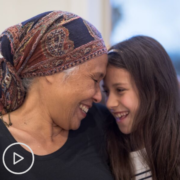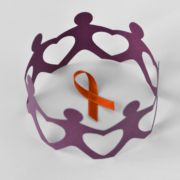Combination AML Therapy for Newly Diagnosed Patients | What Are the Long-Term Effects?
Combination AML Therapy for Newly Diagnosed Patients | What Are the Long-Term Effects? from Patient Empowerment Network on Vimeo.
A Patient Empowerment Network community member wants to know the length of time that patients can stay on the combined treatment of azacitidine (Vidaza) and venetoclax (Venclexta). AML specialist Dr. Jacqueline Garcia responds, sharing an update on the long-term follow-up data for this combination treatment.
Dr. Jacqueline Garcia is an oncologist and AML researcher at the Dana-Farber Cancer Institute. Learn more about Dr. Garcia.
Related Resources:

|

|

New and Emerging AML Therapies Being Studied in Clinical Trials |
Transcript:
Katherine Banwell:
Jerry had this question. “How long can patients stay on azacitidine (Vidaza) and venetoclax (Venclexta) before relapse or toxicities force them to abandon treatment?”
Dr. Jacqueline Garcia:
So, this is a good question. I would say azacitidine and venetoclax just got FDA-approved just shy of five years now, and it’s totally changed our treatment paradigm in many great ways. It was initially approved for patients that could not get intensive chemotherapies or were above 75. We call these our older patients, our more vulnerable.
And we demonstrated and compared to azacitidine alone. It was given with placebo. We saw that the combination of azacitidine and venetoclax not only was safe, well-tolerated, it led to two-and-a-half times higher complete remission rates and impressively longer survival. That’s all we care about, patients are living longer. So, one of the things that we are appreciating in 2023 now, now that we have more patients on azacitidine and venetoclax, is that we have many patients that are long-term responders.
So, in the original clinical trial we’ve been reported – and we just submitted the update for the long-term follow-up that we presented at the American Society of Hematology meeting in 2022, in December.
We presented the long-term follow-up data that shows that responses can be durable and even as long as two years or three years in some patients. The average amount of time the patients are on therapy is somewhere between one-and-a-half to two years. But not every patient performs like an average patient.
We have some that respond for less time. We have some that respond for a longer time. So, I definitely have a few patients that have been on combination therapy, and we’ve gone to year three, then four, and two that got to year five. And that was using the original indication of older the 75, no intensive chemotherapy. Most of those patients in the original trial and led to the approval were not transplant candidates. But once those drugs got approved, more patients that were older started getting this therapy.
And so, the durability of this treatment might be longer for people that don’t have competing health problems and for specific mutation subtypes. There are a couple of mutation subtypes that include IDH2 and NPM1, where we’ve seen some extreme long-term responders.
And then, there are others that are much shorter. So, I would say it’s very individual. In terms of toxicities in general, the regimens very well-tolerated. And if it’s not, often it’s because there should be supportive care, prophylaxis, and adjustments to the dosing strategy, which has been well-published. Sometimes, if you have a treating oncologist that is less familiar, they won’t know the nuances of how to adjust the doses, so I would ask your local oncologist to reach out to anybody that was part of the original trials. Often, a lot of us are very responsive to helping out our colleagues to help patients to stay on treatment.
But at the end of the day, if a patient loses response or has a bad toxicity that makes it very difficult, we have to move on to another therapy.










